Research projects
Ongoing and past projects
Ongoing projects
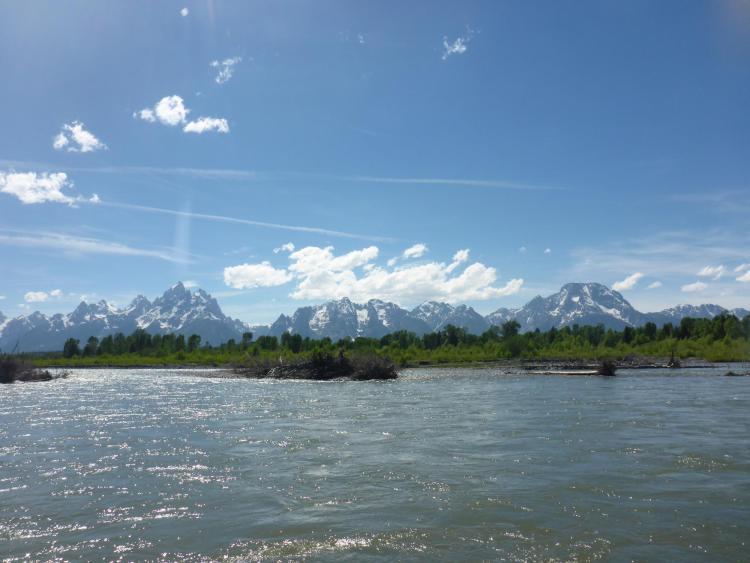
Assessing how humans have altered floodplain organic carbon stocks across the contiguous United States
This NSF-funded project provides a comprehensive estimate of floodplain organic carbon storage across the conterminous United States to determine the impact of human activities on floodplain carbon storage. Recent work has indicated that floodplains likely store more carbon in floodplain soil, vegetation, and downed wood relative to areas outside of floodplains, but there is a lack of information on where and how much carbon is stored in floodplains. We plan to (1) compare floodplain carbon storage in human modified and unmodified floodplains through extensive fieldwork, (2) use field-based estimates of floodplain carbon storage to determine whether it is accurate to use publicly available geospatial datasets to estimate floodplain carbon storage, (3) determine how much carbon is stored in floodplains and the potential storage if human modifications (for example, levees, dams, and land use change) were reduced, and (4) create course modules for high school, undergraduate, and graduate students and disseminates outreach materials for non-profit organizations. The project builds a science of floodplain carbon storage to apply new data and analysis to floodplain management. It also helps determine the locations within watersheds where maximum floodplain carbon storage occurs. Fieldwork locations include the Snake River in Grand Teton National Park, the Rum River in Minnesota, and the San Pedro River in Arizona.
Related publications include:
Lininger, K. B., & Lave, R. (2024). River restoration can increase carbon storage but is not yet a suitable basis for carbon credits. BioScience, biae083. https://doi.org/10.1093/biosci/biae083
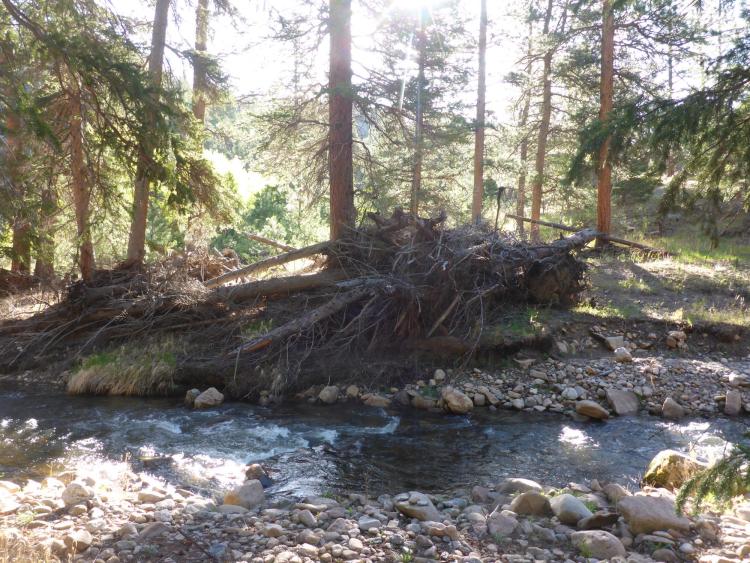
Transport, deposition, and storage of floodplain large wood in river corridors
Downed, dead wood on the floodplain influences geomorphic processes and provides ecological benefits to river corridors. However, understanding the interactions between floodplain vegetation, wood, and hydrogeomorphology is a new frontier in geomorphic research. This project investigates the geomorphic setting in which floodplain large wood jams can be deposited in the Colorado Front Range and the potential geomorphic, hydrologic, and ecological impacts of floodplain large wood jams in the semi-arid western US.
An NSF-funded portion of this research theme will combine flume experiments, numerical modelling, and field observations integrating floodplain forest stand characteristics, hydrogeomorphology, and wood transport and deposition during floods to assess the controls on wood deposition in floodplains and subsequent wood remobilization. The research objectives include (1) understanding the role of the forest stand density on the deposition and storage of wood in floodplains, (2) unravelling the importance of floodplain and channel morphology on floodplain wood dynamics, and (3) assessing overbank flow conditions needed to deposit and remobilize wood onto and from the floodplain to better understand wood jam formation and persistence. Flume experiments will simulate different forest stand densities, overbank flow conditions, and wood transport regimes. The data gathered during the physical experiments will provide baseline information needed to develop empirical relationships for floodplain flow-forest-wood-morphologic interactions. The flume experiments will be used to test and enhance a 2D hydrodynamic model to further explore wood dynamics on floodplains, which will then be applied to a field site where large amounts of floodplain wood jams are present due to a recent flooding event. The results of the project will be disseminated to management agencies and restoration groups in the US and Europe that are incorporating floodplain wood into efforts to enhance floodplain ecosystem functioning. This project will also develop K-12, undergraduate, and graduate level flume laboratory assignments and lessons on floodplain dynamics.
Related publications include:
Guiney, M. and Lininger, K.B. (2022). Disturbance and valley confinement: controls on floodplain large wood and organic matter jam deposition in the Colorado Front Range, USA, Earth Surface Processes and Landforms. https://doi.org/10.1002/esp.5321
Lininger, K. B., Scamardo, J., and Guiney, M. (2021). Floodplain wood and organic matter jam formation after a large flood: investigating the influence of floodplain forest stand characteristics and river corridor morphology. Journal of Geophysical Research: Earth Surface. https://doi.org/10.1029/2020JF006011.
Lininger, K. B., Wohl, E., Sutfin, N. A., & Rose, J. R. (2017). Floodplain downed wood volumes: a comparison across three biomes. Earth Surface Processes and Landforms, 42(8), 1248–1261. https://doi.org/10.1002/esp.4072
Dynamic storage of water, sediment, and carbon in the critical zone
Geomorphic complexity created by large wood, beaver, and geomorphic variation influences storage patterns and timescales in mountain rivers and floodplains, which are an integral component of the critical zone. As part of the Dynamic Water Critical Zone Collaborative Network, we are 1) investigating the role of beaver dams in attenuating and storing sediment, and carbon over decadal timescales, 2) assessing how large wood and other retentive features influences CPOM transport and storage in ephemeral and intermittent streams, and 3) exploring the impact of beaver activities on biogeochemical processes.
Related publications include:
Rees, J. C., Lininger, K. B., Landis, J. D., & Briles, C. E. (2024). Assessing controls on sedimentation rates and sediment organic carbon accretion in beaver ponds. Science of The Total Environment, 949, 174951. https://doi.org/10.1016/j.scitotenv.2024.174951
Fogel, C. B., & Lininger, K. B. (2023). Geomorphic complexity influences coarse particulate organic matter transport and storage in headwater streams. Frontiers in Water, 5, 1227167. https://doi.org/10.3389/frwa.2023.1227167
The geomorphic controls on large wood in river corridors
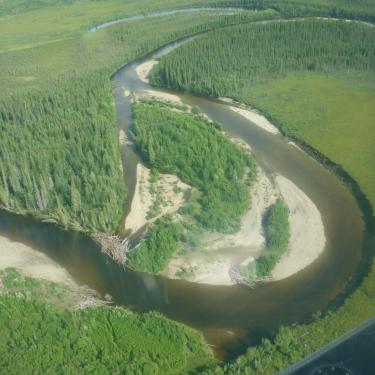
Large wood in river corridors can enhance physical complexity, provide nutrient-rich sites for seedling establishment, create habitat for diverse biota, and provide an important reservoir of organic carbon. We have ongoing work on the geomorphic controls on logjam formation in high-latitude rivers, wood budgets over long time scales using temporally extensive field datasets, and other work related to wood in river corridors.
Related publications include:
Cathcart, C.N., Falke, J.A., Fox, J., Henszey, R., and Lininger, K. B. (2024). Multiscale processes drive formation of logjam habitats and use by juvenile Chinook salmon across a boreal stream network in Alaska, River Research and Applications.
Ockelford, A., Wohl, E., Ruiz-Villanueva, V., Comiti, F., Piegay, H., Parsons, D., Darby, S.,…..Lininger, K. B.,….et al., (2024). Working with Wood in Rivers in the Western United States, River Research and Applications. https://doi-org.colorado.idm.oclc.org/10.1002/rra.4331
Wohl, E., Kramer, N., Ruiz-Villanueva, V., Scott, D. N., Comiti, F., Gurnell, A. M., Piegay, H., Lininger, K. B., Jaeger, K. L., Walters, D. M., Fausch, K. D. et al. (2019). The Natural Wood Regime in Rivers. BioScience, 69(4), 259–273. https://doi.org/10.1093/biosci/biz013
Wohl, E., Scott, D. N., & Lininger, K. B. (2018). Spatial distribution of channel and floodplain large wood in forested river corridors of the Northern Rockies. Water Resources Research, 54, 7879–7892. https://doi.org/10.1029/2018WR022750
Impacts of beaver on sediment storage at the watershed scale
Beaver modify river corridors by building dams, promoting multi-thread channel planforms, and enhancing physical complexity. We are working to better understand the potential for beaver activity distributed throughout a watershed to store sediment and reduce sediment delivery to downstream reservoirs in the Muddy Creek watershed near Paonia, Colorado. This collaborative work will include field datasets that will calibrate numerical models to explore scenarios of beaver expansion and the impact it will have on watershed sediment storage.
Past projects
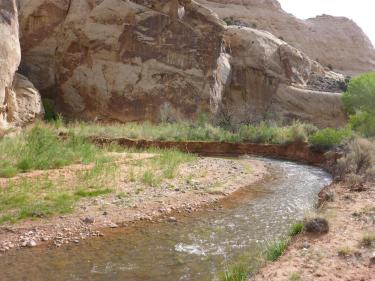
The influence of knickpoint-related incision on floodplain inundation and riparian vegetation
This project investigated how incision upstream of a human-made knickpoint on the Fremont River in Capitol Reef National Park influenced floodplain inundation patterns and riparian vegetation communities. We found that incision resulted in reduced flooding extent and duration, shifting riparian vegetation to dry-adapted species compared to a reference reach. This work informed understanding of fluvial ecogeomophic dynamics in a highly visiting national park.
Related publications include:
Johaneman, T. M., Lininger, K. B., Schook, D. M., Pitlick, J., & Martin, M. (2023). The Influence of Knickpoint Development and Channel Incision on Riparian Vegetation in Semi-Arid River Corridors. Water Resources Research, 59(10), e2023WR034872. https://doi.org/10.1029/2023WR034872
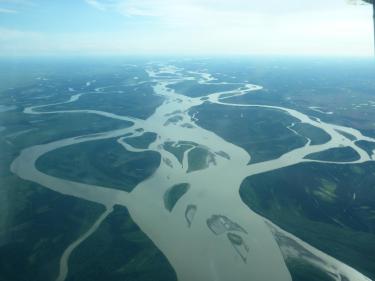
Floodplain organic carbon storage in the central Yukon River Basin
This project investigated the spatial distribution of floodplain soil organic carbon and large wood in the Yukon River Basin in interior Alaska. We found that geomorphic processes influence soil organic carbon concentrations across spatial scales, and that current estimates of soil organic carbon in permafrost regions are likely underestimating the amount of carbon stored within floodplains.
Related publications include:
Lininger, K. B., Wohl, E., Rose, J. R., & Leisz, S. J. (2019). Significant floodplain soil organic carbon storage along a large high latitude river and its tributaries. Geophysical Research Letters, 46, 2121–2129. https://doi.org/10.1029/2018GL080996
Lininger, K. B., & Wohl, E. (2019). Floodplain dynamics in North American permafrost regions under a warming climate and implications for organic carbon stocks: A review and synthesis. Earth-Science Reviews. https://doi.org/10.1016/j.earscirev.2019.02.024
Lininger, K. B., Wohl, E., & Rose, J. R. (2018). Geomorphic Controls on Floodplain Soil Organic Carbon in the Yukon Flats, Interior Alaska, From Reach to River Basin Scales. Water Resources Research, (54), 1934–1951. https://doi.org/10.1002/2017WR022042
Flooding patterns and floodplain lake connectivity on a large tropical river system
The Araguaia River in central Brazil is a large tropical river with many highly connected floodplain lakes. This project analyzed flood attenuation patterns using discharge records along the middle Araguaia River. It also used satellite imagery to characterize surface water connectivity between the main channel and floodplain lakes. We found that there is significant storage in floodplain lakes that likely influences the extreme flood attenuation observed in the middle Araguaia River.
Related publications include:
Lininger, K. B., & Latrubesse, E. M. (2016). Flooding hydrology and peak discharge attenuation along the middle Araguaia River in central Brazil. CATENA, 143, 90–101. https://doi.org/10.1016/j.catena.2016.03.043

